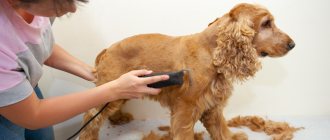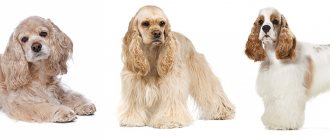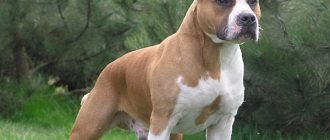You have become the proud owner of an English Cocker Spaniel puppy. Let's take a closer look at what age and where to start training your new pet. Let's consider at what age what to focus on in education and training. Let's not forget about socializing the dog on the street and with other dogs. We will also compare independent classes and classes with a dog handler (in a group and individually).
|
Features of behavior and character
The character of a spaniel can be different, which is explained not only by its varieties, but also by the conditions in which it is placed after the kennel. Whether it is an English, Russian or American cocker spaniel, there are certain rules: in order for a dog to grow up as a friend and helper, in addition to daily activities and regular training, it needs human care, attention and affection. Despite their physique, spaniels have an active and playful character.
Being on a wave of positivity, they need timely training, otherwise they risk becoming stupid.
Spaniels are very friendly and inquisitive. They strive to be in the company of those who care for them, love them and feed them. In the absence of proper attention and with long loneliness, they are characterized by destructive behavior. Therefore, the breeder of these dogs must have enough time so that he can raise his pet to be a good friend and faithful companion.
Dogs of this breed are characterized by a willingness to please their owner. This trait can be taken as a basis for education and training, making it easier to conduct classes. Dogs understand what is needed from them; they subtly sense the intonation of the voice and the manner of speech. They have excellent adaptability, patience, and energy.
But, along with advantages, character also has negative sides. For example, animals can be stubborn and independent. The dog can weigh the relevance of each command given, considering whether it is really worthy of execution.
If training is improper, the pet takes on the role of a teacher and often manipulates the owner.
At what age should you start parenting?
As a rule, puppies are taken from the nursery at 2 months. At this time, they are already familiar with such a concept as socialization and have a stronger psyche. Two-month-old puppies are active, learn to play with each other, stand well on their paws, run a lot and are constantly moving. Considering that the period of adaptation to a new place and owner can last 6-7 months, the sooner the puppy is adopted, the better.
However, experts recommend picking up a puppy no later than three months.
This is explained by the fact that at a later age the dog will not be particularly willing to strive for training and education. Moreover, the speed of learning may slow down, waywardness and persistence may appear. So, the minimum age for starting training is 2 months, the maximum is 3.
The subtleties of raising a puppy
They begin raising the baby immediately after he appears in the house, choosing a day off for this. If you give him a lot of time to adapt, you may miss the time to stop the wrong behavior. In the first days, you can put a heating pad or a small fur mattress in the bed. Under no circumstances should a puppy be placed in a human bed. The puppy is accustomed to its place from the first day of its stay in the new home.
To do this, pat the litter with your hand and say the word “place.” Along with this, the baby begins to accustom himself to his nickname. This is an important step on the path to training, because first the dog must learn to understand when the owner is addressing him. On the very first day, you can wash the puppy so that he can dry and run around until the evening. Then it is washed no more than once a month.
The owner feeds the puppy, he also walks, pets, communicates and plays when the baby requires attention.
However, you cannot pamper your spaniel too much, since during the training process the dog understands that there are times when the owner cannot pay attention to it.
There should be no raising of the voice, as well as shouting, in communication and education. The paws and belly are wiped after each walk and washed if necessary so that dirt from the street does not enter the rooms of the house.
It is especially important for the baby to take care so that he does not feel lonely after separation from his mother dog. Call the puppy by name during games, pet it and talk to it. They buy toys for the baby, play with him, while talking to him and calling him by name. As you understand, you can teach the puppy basic commands, such as “no”, “fu”, “come”. In the first months of life, when pronouncing a command, there should be no unnecessary words and huge tirades: the pet simply will not understand what is required of it.
Along with accustoming him to a nickname, his own place and some simple commands, the owner must regularly carry out hygiene procedures. You should not allow the puppy to walk around dirty in the house; you need to clean its ears, comb its fur, and take care of the condition of its teeth. If you teach your child hygiene from childhood, it will become the norm for him, and therefore he will not be nervous during it.
If during play your pet grabs an object with its teeth, you should not pull it out by force.
You can’t keep a spaniel on a leash all day, the baby can break the chain, whine and complain in his own way, which will bother all the neighbors. In addition, he can become aggressive, which can turn into a parenting problem.
At first, a dog living in an apartment building will have to be carried for a walk in your arms. Someone uses a backpack for this, and the puppy quickly understands that he is going for a walk as soon as he sees the backpack in the hands of the owner.
How to train a dog correctly?
When the spaniel is 3-4 months old, it must be trained to the “near” command. In addition, at this time it is time to teach your pet the commands “stop”, “show teeth”, “collar”. At this time, the baby understands the hours of meals if the owner feeds him on time. For education and training to be successful, several key rules must be taken into account.
- Everything has its time. If you shift upbringing and training from day to day, blaming everything on lack of time, you won’t be able to raise a dog.
- Regularity. It is necessary to train your pet every day so that the animal can consolidate its skills by learning the norms of behavior.
- Moderation of load . You cannot mix several commands at the beginning of training, as the pet will confuse their meaning.
- Patience. If the child follows the command correctly, he must be encouraged; if he cannot learn the lesson, you must not raise your voice at him or offend him with lack of attention.
- Game approach. Spaniels are cunning animals, and therefore they can quickly get bored with monotonous training. Without a creative approach, they will get bored and try to take the parenting initiative into their own hands.
- Personal contact. You should not delegate upbringing and training to someone else, because personal communication is the key to a trusting relationship between the dog owner and the pet itself.
General recommendations
Spaniel training at home is hard work that does not tolerate inattention and letting the situation take its course. During training, the dog must learn not only to carry out any commands spoken by the owner. She must also understand and stop certain actions on the owner's command.
The training can be based on the training of I.P. Pavlov , which allows you to develop reflexes taking into account conditioned and unconditioned stimuli. The trainer can influence the dog using different techniques, for example, encouragement or prohibition. To turn a reward into a conditioned stimulus, you need to connect it with some kind of treat. With frequent rewards, the dog will quickly understand what is required of it, and this technique will have a beneficial effect on its attachment to its owner.
It is useless to force a spaniel to train. Neither a tug on the leash, nor a blow with a rod, nor a threatening intonation will make the spaniel obedient and flexible. On the contrary, they will be the reasons for the dog’s insecurity and fear of the owner. To prohibit your pet from doing something, just say the command “no”. Of course, at first it will not be easy to get used to the same leash or collar.
However, rather than screaming and hitting the animal, it is more advisable to come up with a more positive way to train it.
You should not jerk the collar sharply, even if your pet really wants to run away and explore the world around him.
By doing this, the owner shows superiority, but this does not contribute to proper relationships. The teaching principle should be based on team unity, action and encouragement.
For example, the “sit” command is taught by light pressure on the puppy’s croup. As soon as the pet sits down, he is praised and encouraged. The “take” command is taught during one of the feedings. Food is given to him on the command “take”, thereby teaching him patience, because the dog must understand the order. Otherwise, for example, when hunting, she may rush after the game ahead of time.
The “no” command begins to be practiced from the “young claws”, at the bowl. In this case, food is given with the command “take” so that the puppy understands that he is allowed to eat. At the initial stages of teaching the “no” command, you can use a leash. In the future, it is removed, trying to avoid physical impact. The “come” command is considered one of those that puppies get used to faster than others.
You can accustom a puppy to it in literally a month using reward techniques. You can invite him to your place by treating him to some delicacy. However, when calling your pet, you must remember and follow the order of actions. First they give a command, then they show a treat and only after that comes reinforcement. When training, you can use a whistle: it will serve as a kind of signal to carry out the command.
For more information on training a spaniel, watch the video below.
Commands that are more classified as prohibiting
The “sit” command disciplines the puppy even more. To get your baby's attention, show your cocker his favorite treat, then raise your hand to chest level and say the command "sit." With your other hand, apply gentle pressure on the dog's body so that he can take the desired position. Don't forget to pet your puppy and give him treats for doing it right. If the puppy does not want to sit down and is constantly fidgeting, then trick him into doing so. Place the treat behind the puppy's head and follow it with your eyes, so the puppy will sit down. The “sit” command is also used to calm the baby, or while waiting for the owner. You should not use this command before play, as the puppy may perceive this command as part of the game.
The next command, which also belongs to the prohibitive category, is “fu” or “no”. Training this command is extremely important in everyday life. Puppies love to play and chew everything they come across. They also try their best to taste the environment. Such a command will help to instill certain norms of behavior in the puppy. After pronouncing and assimilating this command, the puppy will not eat from someone else’s hands, drink from a puddle, bite hands, etc. To teach a puppy to carry out a prohibiting command, it is best to watch when the baby does harm and shout the command threateningly. The puppy will turn around, look at you, and you must repeat the prohibition again.
Remember that you should only raise your voice if your puppy is prohibited or exhibiting unacceptable behavior. This will allow the baby to get used to hearing his voice rise when he does something forbidden. The cocker must remember the specific words spoken at such moments and the intonation. Use only one phrase.
Another important basic command is “to me.” With its help, you can call your cocker spaniel puppy to you if he has run away from you for a long distance. It also helps to call your pet for feeding or to begin the training process. In order for the puppy to run to your call, first interest him in something. You can use a treat or a toy as bait, or even regular food; in short, do whatever you can to lure the puppy to you. Another way to call your puppy to you is with a whistle.
Nothing helps? We have an online school. Sign up!
Find out more
sign up
To master the “lie down” command, bring your cocker spaniel puppy over and command him to sit. Then let him see that you have a treat hidden in your hand, then give the "down" instruction and make a reaching motion with your hand. In an attempt to get what he wants, the baby will lie down. Do not forget about rewards and also when the dog tries to rise, lightly press on the withers from above and hold it in a lying position.
Training a Cocker Spaniel Puppy, When to Start
Training an American Cocker Spaniel puppy must begin from the very first days.
the presence of a dog in your home. There is an opinion that puppies should be trained no earlier than 6 months, but this opinion is erroneous, although quite widespread. From infancy, you need to instill in your dog the rules of behavior in your home, what is allowed and what is prohibited.
Often new puppy owners worry that training from the first days will be excessively stressful for the dog. This is only possible if outdated rigid methods are used, and with the right approach, training from the first days will be, on the contrary, very useful, since it allows you to immediately establish contact
with the puppy and build a trusting relationship.
Features of American Cocker Spaniels
The American Cocker Spaniel is now not only a hunter, but also an excellent companion. Representatives of this breed very sensitively sense the mood of their owner, will never impose themselves and, if necessary, on the contrary, will try to encourage the owner.
This is a very friendly and loyal dog that always bonds with its owner and his family. Therefore, you should not leave her alone for a long time, this will affect not only the relationship, but also trust.
The American Cocker Spaniel, although quite calm, still prefers joint active games with its beloved owners.
This breed is highly trainable, very obedient if properly raised, affectionate and friendly if you have built a trusting relationship in time.
The American Cocker Spaniel has a sense of self-esteem and aristocratic manners, while always being full of enthusiasm and ready to make contact with both owners, children, and other animals.
Charming representatives of this breed need proper upbringing and timely training; in this case, their playful disposition and curiosity will be directed in the right direction and you will not need to correct unwanted behavior, which is caused by the mistakes of the owners.
Raising a 2 month old Cocker Spaniel puppy
At 2 months old, your American Cocker Spaniel puppy is still at home, in quarantine after the first vaccinations, and he is not yet allowed to go for walks. Therefore, it’s time to start raising a puppy in familiar home conditions.
The first step is teaching the puppy to go to the toilet in a diaper . At the same time, it should be remembered that any learning is a rather complex thing, and when you see the first positive results, you should not think that your puppy has already understood everything, but you should continue training according to the method, so that after a while you do not have to start all over again.
The second important point will be to accustom the puppy to a collar and leash . Yes, yes, this should be done at home, so that by the time the puppy goes outside for the first time, wearing a collar will not be additional stress for him, but is already a familiar thing, and he can begin to explore the world around him, rather than trying get rid of an unknown object.
The third point, which causes the greatest difficulties for new puppy owners, will be the definition of the puppy’s boundaries of what is permitted :
- Teach to play only with your toys, and not with your things;
- Explain that you cannot bite your hands even in a game;
- Establish the correct daily routine, establishing the rule that in the morning you need to sleep and not wake you up;
- Stop chewing furniture, clothes, walls and baseboards;
- Teach to stay home alone, knowing that your absence is not a reason to bark or howl.
The need for walking puppies
Remember that you need to walk your puppy constantly and preferably at the same time. It is very difficult for little ones to restrain their natural needs, so walking at one specific time will allow the body to get used to it. And you will know when your baby needs to go outside. When a cocker puppy grows up, he may already ask to go outside if necessary. If in the morning your dog wakes you up earlier than expected or starts whining, barking and running towards the door, you need to urgently take him outside.
Cocker spaniels are highly trainable because they have a good memory. Remember that there must be a connection between you and your pet. This will allow the puppy to perceive you as his leader, and he will delight you in following commands.
Socialization of a Cocker Spaniel puppy at 3 months
Three months is an important stage in introducing an American Cocker Spaniel puppy to the outside world. Your first walks should be short and not too tiring for the puppy.
At this age, the puppy’s nervous system is forming.
, so it is necessary to show him as much as possible: noisy streets, large crowds of people, etc. This must be done very carefully, gradually, over and over again increasing the time spent in noisy places, so as not to overload the puppy and not frighten him.
It is also necessary to introduce the puppy to friendly dogs and people.
so that later the puppy does not develop aggression or cowardice caused by the fear of new things and the inability to communicate and make new acquaintances. And this is currently, unfortunately, not uncommon in the behavior of adult dogs, but a fairly common problem with which people turn to our specialists for help.
The emergence of new places leads to new rules that need to be consolidated:
- Now you can and should go to the toilet on the street, rather than steadfastly endure and carry everything home;
- Not every new person or dog wants to communicate, so you don’t need to run headlong to meet everyone;
- Not all food is healthy, so it should only be taken from the owner’s hands.
Training a puppy follows the same principles as at 2 months. It should be remembered that at this age puppies develop conditioned reflexes quite easily, but they are also quickly forgotten, so you should not scold the puppy for not following commands, especially if they have not been repeated for a long time, but you should pay more attention to learning new things and repeating already learned material .
Basic commands
You will use some commands more often, others less often. But they will still come in handy to easily interact with the American Cocker Spaniel and even keep him safe in various situations.
- Aport. One of the most difficult teams. Many people perceive it as very easy and simple, but with many dogs you will have to work hard. This skill is used for other exercises: searching, searching, selecting an item and many others. Usually they are all used in service. When working out a command, “Aport” and “Give” are used, and a gesture is also used.
- Give. On the command “Give” the dog must give up the object.
- Lie. A connecting command that needs to be learned for other commands. In addition, it will not interfere at home or on the street.
- To me. You will need to use this command quite often. So start with it immediately after your American Cocker Spaniel puppy has learned his name. Never call the dog to punish, and do not scold if it comes on its own, even after mischievousness before it. This behavior on your part may alienate the animal.
- Place. A puppy or an adult dog must clearly know where his place is located. He can sleep anywhere, if you allow it, of course, but he must know this command. You can use it outside the home, marking the place with a leash or your favorite toy.
- Near. It is possible to teach your pet the “Near” command at any age, be it an adult dog or a small puppy. When you move to a new home, you should immediately think about training your puppy.
- Sit. One of the very first commands that an American Cocker Spaniel puppy should learn.
- Stand. The command is useful in everyday life, for example, for combing a dog.
- . The prohibiting command is one of the most mandatory and taming it begins from the first day the puppy appears in the house. Requiring the command “Fu!”, “No!”, “No!” - immediately stop the unwanted action.
Training a Cocker Spaniel puppy at 4 - 5 months
By this time, the American Cocker Spaniel puppy has already become accustomed to your home and usual walking areas, and no longer needs your support and care so much. Therefore, he begins, flirting with other dogs, pretending that he does not hear you when you call him, and showing a certain persistence and disobedience when executing various commands.
This means it’s time to move on to full training . In classes at this age you can already be persistent and demanding. At the same time, the most important thing is not to overdo it, remember that classes should bring joy to both you and your dog, and only then will you be able to achieve the desired result.
What commands are practiced by an American Cocker Spaniel puppy at 4 months:
- Calm movement next
to the owner with and without a leash, with landing when stopping, with a change in pace and direction of movement - Return to you
upon request - Staying
in a free or certain position (sitting, lying, standing) for a long time: if necessary, wait for the owner on the street, when visiting a store or other establishment - Indifferent attitude towards treats scattered on the ground
- Inhibitory command
to stop unwanted actions - Execution of a set of commands “sit”, “lie down”, “stand”
at a distance and near the leg, when giving commands by voice and gestures - Stop barking
on demand.
Dog trainer for cocker spaniel
The most correct solution would be to train a cocker spaniel under the guidance of a professional dog handler.
Training a Cocker Spaniel is, first of all, about proper interaction with your dog, gaining its trust and respect, and only then explaining commands to it. In this case, your cocker spaniel, knowing perfectly well the various commands, will carry them out not only when he wants it, but when you need it, in the presence of other dogs and other distractions.
Our specialists will teach you how to behave in a given situation when communicating with your dog, what to allow, what to prohibit, how to praise and how to express your disapproval in case of unwanted actions on the part of your dog.
When studying obedience commands, our dog trainers will teach you all stages of practicing commands, and your dog will clearly follow commands even with strong distractions.











